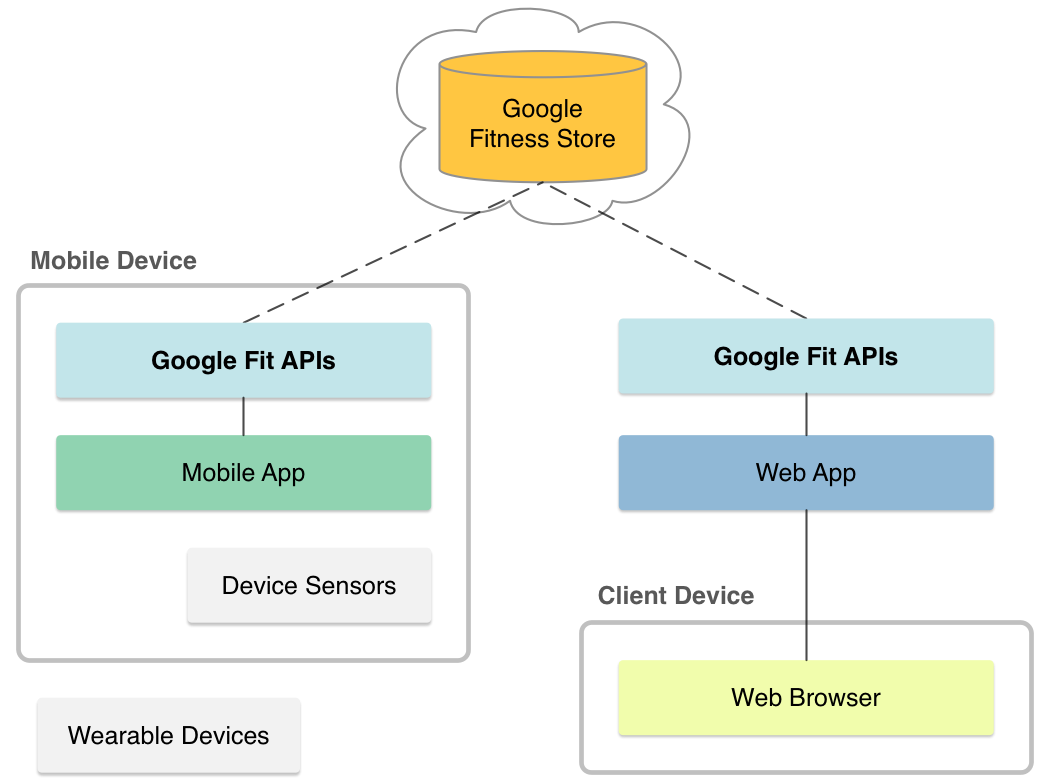Google Fit هو عبارة عن منظومة متكاملة مفتوحة. فهي تتيح للمطوّرين تحميل بيانات الصحة والعافية إلى مستودع مركزي حيث يمكن للمستخدمين الوصول إلى بياناتهم من أجهزة وتطبيقات مختلفة في مكان واحد. لا يزال بإمكانهم الوصول إلى بياناتهم في حالة الترقية إلى جهاز جديد.
يمكن لتطبيق الصحة والعافية تخزين البيانات من أي جهاز قابل للارتداء أو أداة استشعار، والوصول إلى البيانات التي أنشأتها تطبيقات أخرى.
اقرأ سياسة بيانات المستخدمين والمطوّرين في Google Fit بدقة وتأكد من التزام تطبيقك بها. يُرجى مراجعة أحكام وشروط Google Fit بعناية قبل استخدام التطبيق. يعني استخدامك لواجهة برمجة التطبيقات أنك توافق على أحكام وشروط Google Fit.
المكوّنات
يتألف Google Fit من المكوّنات التالية:

- متجر اللياقة البدنية
- مستودع مركزي يخزِّن البيانات من مجموعة متنوعة من الأجهزة والتطبيقات. متجر اللياقة البدنية هو خدمة سحابية شفافة للعملاء.
- إطار عمل المستشعر
- مجموعة من العروض العالية المستوى التي تسهِّل التعامل مع متجر اللياقة البدنية. ويمكنك استخدام هذه البيانات مع واجهات برمجة تطبيقات Google Fit.
- الأذونات وعناصر تحكّم المستخدم
- مجموعة من نطاقات التفويض لطلب إذن المستخدم للتعامل مع بيانات الصحة والصحة. يتطلب Google Fit موافقة المستخدم للوصول إلى بيانات الصحة والعافية.
- واجهات برمجة التطبيقات في Google Fit
- واجهات برمجة تطبيقات Android وREST للوصول إلى متجر اللياقة البدنية يمكنك إنشاء تطبيقات تتوافق مع Google Fit على أنظمة أساسية وأجهزة متعددة، مثل تطبيقات Android وiOS وتطبيقات الويب.
متجر اللياقة البدنية
متجر اللياقة البدنية هو خدمة سحابية تحتفظ ببيانات الصحة والعافية باستخدام بنية Google الأساسية. يمكن للتطبيقات على أنظمة التشغيل والأجهزة المختلفة تخزين البيانات والوصول إلى البيانات التي تم إنشاؤها بواسطة تطبيقات أخرى. يوفر Google Fit مجموعة من واجهات برمجة التطبيقات التي تسهّل إدخال البيانات والاستعلام في متجر اللياقة البدنية.
إطار عمل المستشعر
يحدد إطار عمل أداة الاستشعار تمثيلات عالية المستوى لأجهزة الاستشعار، وأنواع البيانات، ونقاط البيانات، والجلسات. تسهل هذه التمثيلات العمل مع متجر اللياقة البدنية على أي منصة.
- مصادر البيانات
- تمثّل مصادر البيانات أدوات الاستشعار وتتألف من اسم ونوع البيانات التي يتم جمعها وتفاصيل أداة الاستشعار الأخرى. قد يمثل مصدر البيانات مستشعرًا للأجهزة أو أداة استشعار برمجية. يمكنك تحديد أدوات الاستشعار في البرامج في تطبيقاتك.
- أنواع البيانات
- تمثّل أنواع البيانات أنواعًا مختلفة من بيانات الصحة والعافية، مثل عدد الخطوات ومعدّل نبضات القلب. تنشئ أنواع البيانات مخططًا يمكن من خلاله للتطبيقات المختلفة فهم بيانات بعضها البعض. يتكون نوع البيانات من اسم وقائمة حقول مرتبة، حيث يمثل كل حقل بُعدًا ما. على سبيل المثال، يتضمّن نوع البيانات الخاص بالموقع الجغرافي ثلاثة حقول (خط العرض وخط الطول والدقة)، بينما يحتوي نوع بيانات الوزن على حقل واحد فقط.
- نقاط البيانات
- تتكوّن نقاط البيانات من مصفوفة ذات طابع زمني من القيم الخاصة بنوع بيانات معيّن، وتتم قراءتها من مصدر بيانات. يمكنك استخدام نقاط البيانات لتسجيل وإدراج بيانات الصحة والعافية في مخزن اللياقة البدنية، وقراءة البيانات الأولية من مصدر البيانات. والنقاط التي تتضمّن وقت البدء هي نطاق زمني بدلاً من بيانات فورية.
- مجموعات البيانات
- تمثل مجموعات البيانات مجموعة من نقاط البيانات من النوع نفسه من مصدر بيانات معيّن يغطي بعض الفترات الزمنية. يمكنك استخدام مجموعات البيانات لإدراج البيانات في متجر اللياقة البدنية. تعرض أيضًا طلبات البحث لقراءة البيانات من متجر اللياقة البدنية مجموعات البيانات.
- الجلسات
- تمثّل الجلسات فاصلاً زمنيًا يمارس فيه المستخدمون نشاطًا للياقة البدنية، مثل الجري أو ركوب الدراجة وما إلى ذلك. تساعد الجلسات في تنظيم البيانات وإجراء طلبات بحث مفصلة أو مجمّعة في متجر اللياقة البدنية لنشاط اللياقة البدنية.
الأذونات وعناصر تحكّم المستخدم
يتطلّب Google Fit موافقة المستخدم قبل أن تتمكّن التطبيقات من قراءة بيانات الصحة والعافية أو تخزينها. يحدّد Google Fit نطاقات OAuth المرتبطة بعدد من مجموعات الأذونات مع امتيازات منفصلة للقراءة والكتابة، وهي: النشاط والجسم والموقع الجغرافي والتغذية وأنواع البيانات المتعلقة بالصحة (يتم تجميع أنواع البيانات المتعلقة بالصحة بدرجة أدق). تمنح كل مجموعة أذونات التطبيقات إمكانية الوصول إلى مجموعة من أنواع البيانات. تحدّد التطبيقات نطاقًا أو أكثر من هذه النطاقات للعمل مع بيانات الصحة والعافية، ويطلب Google Fit من المستخدم الأذونات ذات الصلة.
واجهات برمجة التطبيقات في Google Fit
يوفّر Google Fit واجهات برمجة التطبيقات التالية:
- واجهات برمجة تطبيقات Android لتطبيقات Android.
- REST API للتطبيقات على أي نظام أساسي

